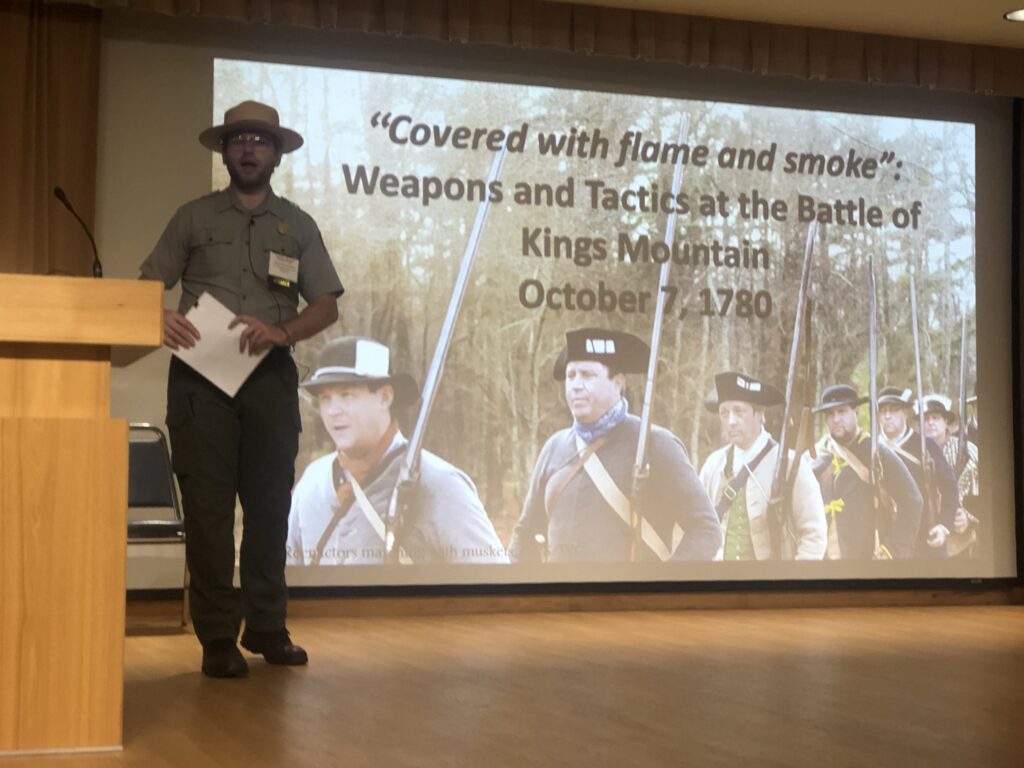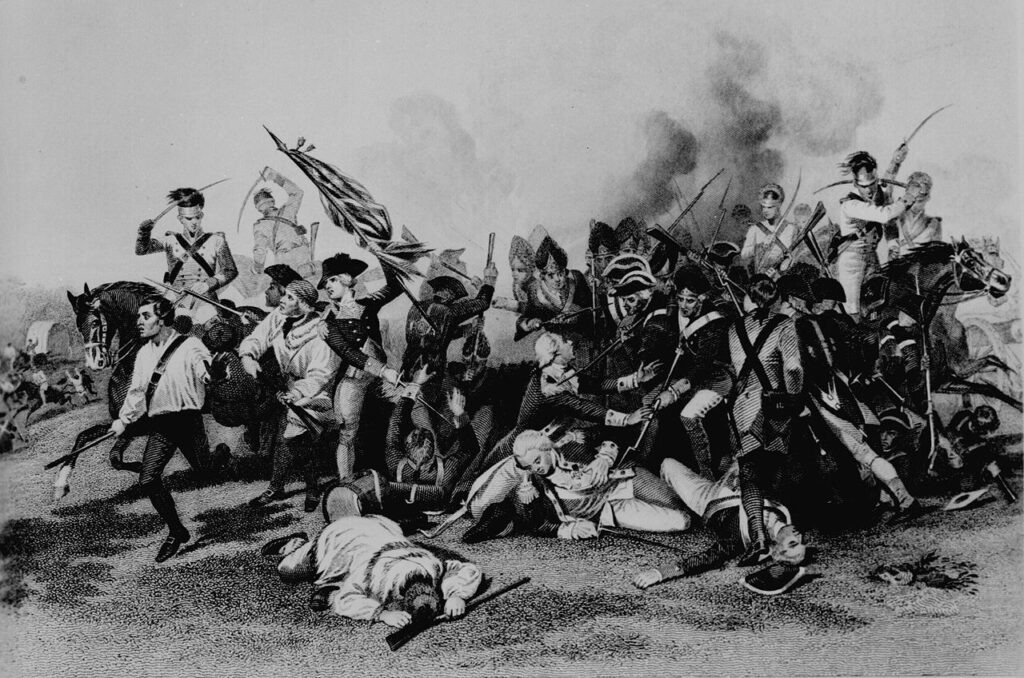I had been anxiously awaiting the 5th Annual American Revolution Symposium: State of Rebellion: South Carolina’s Place in the American Revolution, and it exceeded my expectations in every way.
Two of the presentations on the agenda immediately caught my attention: Bioarchaeology of the Camden Battlefield Burials: Dr. Madeline Atwell and Dr. Bill Stevens, Richland County Coroners Office, and the Cannon Firing Demonstration by the 4th SC Regiment, Artillery.
History, archaeology, forensic anthropology, Revolutionary War battles, Cherokees in the Revolutionary era, Freemasonry during the American Revolution, and cannons! Who wouldn’t sign up? Wait, South Carolina had a navy?
Lessons from the Battle of Camden
The Bioarchaeology of the Camden Battlefield Burials presentation by Dr. Madeline Atwell and Dr. Bill Stevens chronicled an extraordinary project to excavate, study, and respectfully reinter the remains of 14 Revolutionary War soldiers killed in the August 16, 1780 Battle of Camden.
A team of archaeologists from the South Carolina Institute of Archaeology and Anthropology and the South Carolina Department of Natural Resources, along with biological anthropologists from the Richland County Coroner’s Office and the University of South Carolina, unearthed the skeletal remains and accompanying artifacts of 14 Revolutionary War soldiers.
One set of remains appears to have been a native American, and another was a Highlander of the 71st Regiment of Foot. Each will be respectfully conveyed to their respective nations.

“It was fraught with peril,” said Dr. Atwell. “In many cases, because we have never really worked with remains that would crumble if touched. Due to not only having been disturbed in the ground being buried so close to the surface but also the acidity level in the soil that lent itself to the degradation of the bone itself.”
Some of the remains were so delicate that they had to be lifted out of the site in blocks of soil that were then x-rayed, meticulously cleaned, and examined. Stevens also mentioned Archaeologist James Legg’s ability to reassemble some of the buttons recovered, even though some consisted of hundreds of fragments.
DNA and isotropic studies are ongoing, and some soldiers may be identified at some point.
“We submitted molar teeth and hard bone at the base of the skull, called the petrous portion, as our prime candidates for getting a good genetic profile of the individuals that can be compared to people who may have ancestors at the Battle of Camden,” said Dr. Stevens. “(The samples) were sent to some of the most prestigious Paleo genetic labs in the country.”
Revolutionary War Artillery
Tom Oblak, SCBPT 4th SC Regiment, Artillery, discussed the use, ability, and limitations of Revolutionary War artillery and led the demonstration of a British 3-pounder cannon at the end of the day. He pointed out that cannons were primarily line-of-sight weapons at that time, and their main advantage was firepower.
“The loading rate for a cannon crew was four to five times a minute,” Oblak said. “An individual soldier could fire only three rounds a minute. Think of a pit crew in NASCAR. Every member of that crew has one thing to do and they do it very fast. (Grapeshot and canister allowed cannon crews to) put 50 shots in that cannon. A normal infantry company was 20-40 people. I can do that with one shot, and I can do it four or five times a minute. But I can’t sustain that for very long because that barrel will overheat.”
Kings Mountain Tactical and Strategic Considerations
Ranger William Caldwell, National Park Service, gave a dynamic talk about the Battle of Kings Mountain, including accounts, details, technology, and descriptions. He debunked common misconceptions regarding the battle that Loyalist commander Major Patrick Ferguson’s choice of position and failure to use artillery caused his defeat.

“This is not a bunch of bulletproof Mountain men surging up the side, using their expert American hunting skills to defeat a foolish officer who made a bad choice of ground with untrained loyalist levees or traders,” Caldwell said. “These are Patriot frontiersmen who used the skills they had, the experiences, and the abilities they had. And they went from taking Kings Mountain to be in a very, quite possibly, quite likely loyalist victory to this patriot victory, one of the turning points of the American Revolution.”
Freemasonry During the American Revolution
Steven Knapp, Director of the Newberry Museum, covered Freemasonry among the founding fathers and its influences in the colonial Carolinas. Along with debunking more than a few misconceptions, Knapp introduced the audience to John Ferdinand Smyth (Stuart), a scoundrel of unusual depth, breadth, and boldness who will almost certainly find his way into one of my upcoming Carolina Con Artist blog posts.
“I have heard anywhere from five to 13 signers of the Declaration of Independence being Masons,” Knapp said. “There were eight documented signers of the Revolution who we know for a fact were Freemasons. There were ten who it is claimed they were Masons or they became Masons after the Revolution. And then there are 13 where they are claimed, but there’s absolutely no proof about it. This includes guys like Thomas Jefferson and John Adams. Based on what I know about Adams, I don’t think he liked Masons all that much.”
According to Harvard University, the exact count of the signers of the Declaration who were Masons differs from source to source. Eight signers, including Benjamin Franklin, are recorded as being affiliated with specific Masonic lodges: Elbridge Gerry, John Hancock, William Hooper, Richard Stockton, Matthew Thornton, George Walton, and William Whipple.
George Washington was a Freemason but did not sign the Declaration of Independence. He was with the Continental Army in New York when it was signed.
The South Carolina Navy
Joe Long, Curator of Education at the South Carolina Confederate Relic Room and Military Museum, shared the story of the South Carolina Navy in the Revolution. Most of his talk revolved around the frigate Indien, often L’Indien. In 1780, the Duke of Luxembourg chartered her to the navy of South Carolina, and she sailed as the South Carolina.
“I leave to you the wisdom of leasing a vessel that you’re going to take directly into combat, but the vessel was leased for three years,” Long said.
The South Carolina took 15 prizes (captured ships) during her service. In December 1781, she attempted to dash out of Philadelphia through the British blockade. She ran into a squadron of three British frigates that chased the South Carolina for 18 hours and fired on her for two hours before she struck her colors in the Delaware River. The ship’s bell is currently on display at the South Carolina Relic Room.
Perhaps the frigate South Carolina’s greatest significance to history is that marine architect Joshua Humphreys, known as the “Father of the American Navy,” studied her and used the information in designing the United States Navy’s first frigates: the USS Constitution “Old Ironsides” and USS Constellation.
Rounding out the program: Rick Wise, Interim Executive Director, provided an update on the work of the SC Battleground Trust. Alice Taylor-Colbert gave a presentation on Cherokees in the Revolutionary Era. Author Jim Piecuch covered the South Carolina Royalists: A Provincial Regiment. Mike Burgess discussed the Battle of Blackstock’s Plantation.
In Memoriam: Doug Bostick
Many, if not most of the presenters, paid tribute to Doug Bostick, executive director of the South Carolina Battleground Preservation Trust and a noted historian and author of 26 books who passed away earlier this year at the age of 70. The trust stated that during his 14-year tenure, he saved land at nearly sixty historic battlefields throughout South Carolina, bought and conserved thousands of acres of land for public use, and promoted historic preservation as a real untapped and localized economic development tool.
Check out my new book, Blood on the Blue Ridge: Historic Appalachian True Crime Stories 1808-2004, cowritten with my friend and veteran police officer, Scott Lunsford on Amazon. Buy it here!
Additional Sources
Late Leader of S.C. Battleground Preservation Trust and Beloved Storyteller
Remains of Revolutionary War soldiers help USC anthropologists unravel the Battle of Camden
The Fruits of Victory: Loyalist Prisoners in the Aftermath of Kings Mountain
South Carolina Provincials: Loyalists in British Service During the American Revolution

